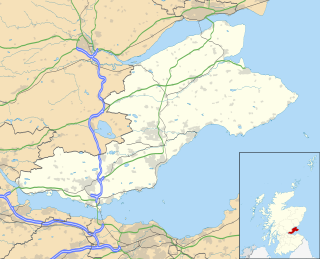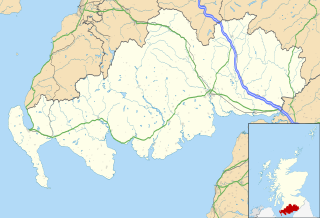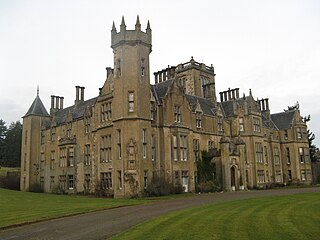Kinglassie is a small village and parish in central Fife, Scotland. It is located two miles southwest of Glenrothes. In 2011, the population of the village was 1,684.

Fraserburgh is a town in Aberdeenshire, Scotland with a population recorded in the 2011 Census at 13,100. It lies at the far northeast corner of Aberdeenshire, about 40 miles (64 km) north of Aberdeen, and 17 miles (27 km) north of Peterhead. It is the biggest shellfish port in Scotland and one of the largest in Europe, landing over 5,450 tonnes in 2016. Fraserburgh is also a major port for white and pelagic fish.

Cupar is a town, former royal burgh and parish in Fife, Scotland. It lies between Dundee and Glenrothes. According to a 2011 population estimate, Cupar had a population around 9,000, making it the ninth largest settlement in Fife, and the civil parish a population of 11,183. It is the historic county town of Fife, although the council now sits at Glenrothes.

Carnoustie is a town and former police burgh in the council area of Angus, Scotland. It is at the mouth of the Barry Burn on the North Sea coast. In the 2011 census, Carnoustie had a population of 11,394, making it the fourth largest town in Angus.

Marischal College is a large granite building on Broad Street in the centre of Aberdeen in north-east Scotland, and since 2011 has acted as the headquarters of Aberdeen City Council. However, the building was constructed for and is on long-term lease from the University of Aberdeen, which still uses parts of the building to house a museum. Today, it provides corporate office space and public access to council services, adjacent to the Town House, the city's historic seat of local government. Many Aberdonians consider Marischal College to be an icon of the "Granite City" and to symbolise the zenith of Aberdeen's granite-working industry.

Annan is a town and former royal burgh in Dumfries and Galloway, south-west Scotland. Historically part of Dumfriesshire, its public buildings include Annan Academy, of which the writer Thomas Carlyle was a pupil, and a Georgian building now known as "Bridge House". The Town Hall was built in Victorian style in 1878, using the local sandstone. Annan also features a Historic Resources Centre. In Port Street, some of the windows remain blocked up to avoid paying the window tax.

Peterhead is a town in Aberdeenshire, Scotland. It is Aberdeenshire's biggest settlement, with a population of 18,537 at the 2011 Census. It is also the largest fishing port in the United Kingdom for total landings by UK vessels, according to a 2019 survey.

New Deer is a settlement in Aberdeenshire, North East Scotland, that lies in the valley of Deer. It was founded after monks from Deer Abbey, Old Deer built a chapel at Auchreddie, which translates as "field of the bog myrtle". Around 1507 the register of Deer Abbey lists its lands in the "new paroche of Deir". The name Auchreddie has dropped in significance over the years, however the southern end of the village is still known by this name.

Longside is a village located in Aberdeenshire, Scotland and consists of a single main street. It lies seven miles inland from Peterhead and two miles from Mintlaw on the A950. Its population in 2001 was 721. The River Ugie flows through it.

Strichen is a village in Aberdeenshire, Scotland. It sits on the A981, connecting it to New Deer 7.2 miles (12 km) to the southwest and Fraserburgh 8 miles (13 km) to the north-northeast, and the B9093, connecting it to New Pitsligo about 4 miles (6.4 km) due west. The village got its name from Lord Strachen. It is situated on the River Ugie at the foothills of Mormond Hill. The Strichen White Horse is constructed of quartz on Mormond Hill, some 1,500 m (1,600 yd) northeast of Strichen.

John Smith was a Scottish architect. His career started in 1805 and he was appointed as the official city architect of Aberdeen in 1807, the first person to hold this post. Together with Archibald Simpson, he contributed significantly to the architecture of Aberdeen, and many of the granite buildings that gave the city the nickname 'The Granite City' or also 'The Silver City' are attributed to them.

George Street is the central thoroughfare of the First New Town of Edinburgh, planned in the 18th century by James Craig.

James Matthews was a prominent 19th century architect in northern Scotland who also served as Lord Provost of Aberdeen from 1883 to 1886 during which time he enacted an important city improvement plan. His work as an architect is largely in the Scots baronial style.

Dyke Parish Church is a Georgian church in Dyke, a village in Moray. In active use by the Church of Scotland since it was built in 1781, it stands on the site of a mediaeval church, and incorporates an older mausoleum, which is now the church hall and vestry. An early mediaeval Pictish cross slab, and a twelfth century coin hoard were discovered in the grounds while the church was being built. It was designated a Category A listed building in 1971.

St Rufus Church, also known as Keith Parish Church, is a Church of Scotland church in Keith, Moray, that was built in 1816. Designed by James Gillespie Graham in the Perpendicular Gothic style, it has crenellated walls, traceried windows and a tall bell and clock tower at its west end. The doorway leading into the nave from the entrance lobby is an unusual war memorial, listing the names of parishioners who died in the First World War on one side, and in the Second World War on the other.
Kirkburn House is a Category B listed building on South Road in Peterhead, Aberdeenshire, Scotland. It was the manse for the adjacent, now-ruined Old St Peter’s Church. Its name refers to the now-culverted burn in the hollow alongside the building.
16 Prince Street is a Category B listed building in Peterhead, Aberdeenshire, Scotland. It dates from 1838. It was formerly Peterhead's infant school, colloquially known as the Chuckney School. Today it is an office building for Aberdeenshire Council.

Old St Peter's Church is a scheduled monument in Peterhead, Aberdeenshire, Scotland. While the medieval main tower is still standing, only ruins remain of its other sections, some of which date to the 12th century. The pyramid roof of the tower is believed to be 18th century.

St. Peter's Church is a Category B listed building located on Merchant Street in Peterhead, Aberdeenshire, Scotland. It was founded in 1814 and incorporates a late-18th century house, which is believed to be the original rectory. Today's structure was built on the site of a 1798 church; it opened for worship on 24 December 1814; it was consecrated on 2 August 1857 by Bishop Suther. The church's architect was Robert Mitchell.

1 Harbour Street is a Category B listed building in Peterhead, Aberdeenshire, Scotland. Dating to the late 18th century, the building stands at the corner of Jamaica Street, onto which the property's garage faces.





















